From bustling street corners to cozy cafes, banh mi has woven itself into the very fabric of Vietnamese culture, particularly in Hanoi. With its eclectic mix of French and Vietnamese influences, banh mi is more than just a sandwich; it’s a culinary experience that tells a story of history, innovation, and tradition. Whether you’re a seasoned traveler or a curious foodie, understanding banh mi offers an intimate glimpse into Vietnam’s rich heritage and vibrant street food culture.
Watch the video summarizing the article “Banh mi Hanoi”
When you first bite into a banh mi, the initial crunch of the baguette gives way to a symphony of flavors and textures: the savory richness of pâté, the refreshing bite of pickled vegetables, the aromatic burst of fresh herbs, and the spiciness of chili peppers. Each element is meticulously crafted to create a harmonious blend, making it a fulfilling and unforgettable meal. In Hanoi, where culinary artistry meets street food convenience, banh mi stands as a testament to the city’s love for bold flavors and quality ingredients.
But what exactly is banh mi? Where did it originate, and how has it evolved over the years? This comprehensive guide will walk you through the multi-layered world of banh mi in Hanoi, exploring its origins, variations, popular ingredients, and the best spots in the city to savor this delightful sandwich. We’ll also delve into how you can recreate the authentic taste of banh mi at home and its vital role in Vietnamese culture.
What is banh mi?
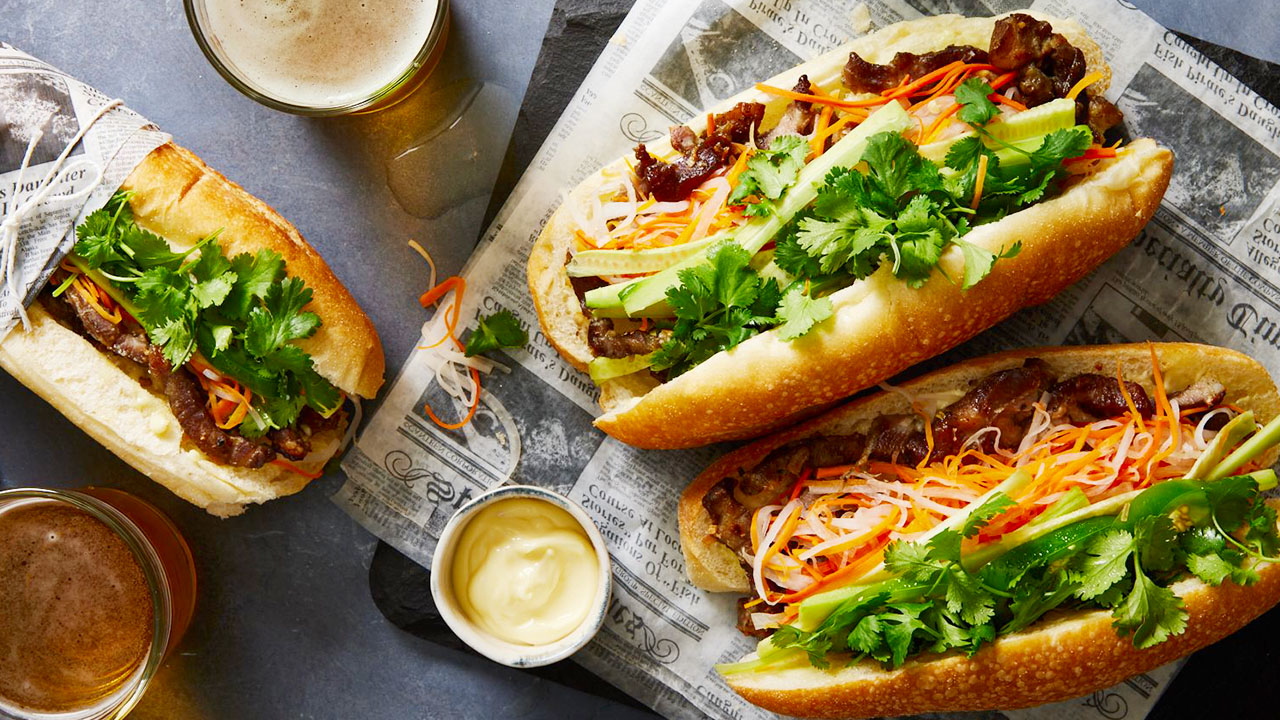
Simply put, banh mi is a sandwich that showcases the fusion of French and Vietnamese culinary traditions. The foundation of banh mi is a crispy, airy baguette, which is a clear nod to the French influence in Vietnam. The baguette is sliced open and generously filled with an array of meats, vegetables, and condiments. But what makes banh mi truly special is not just the bread or the fillings; it’s the ingenious blend of textures and flavors that dance on your palate with every bite.
The traditional banh mi starts with a slathering of pâté, setting a savory base. This is followed by an assortment of proteins, which can range from various cold cuts to grilled meats. The freshness is then added in the form of pickled carrots and daikon radish, which introduce a tangy crunch that cuts through the richness of the meats. Fresh herbs like cilantro bring an aromatic flair, while spicy chili peppers add an exhilarating kick. Additional condiments like mayonnaise and soy sauce elevate the flavors, ensuring each bite is as delightful as the last.
Comparing banh mi to a Western sandwich or a sub only scratches the surface of its complexity. Imagine the meticulous construction of a gourmet dish, where each ingredient serves a purpose and contributes to a cohesive and indulgent flavor profile. It’s this balance of elements that makes banh mi stand out, offering a unique experience that’s both familiar and exotic.
The history of banh mi in Vietnam
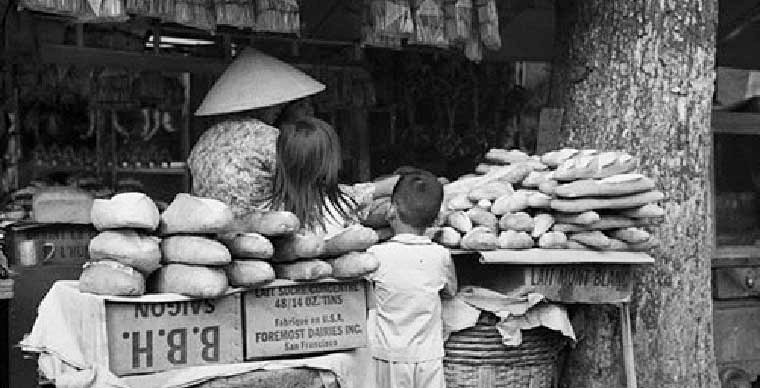
The journey of banh mi began in the mid-19th century when the French colonized Vietnam. They brought with them their culinary staples, including the baguette, butter, and cold cuts. Originally, these luxurious items were enjoyed exclusively by the French and the elite. However, as time went by, the Vietnamese people adapted these ingredients to create something uniquely their own.
By the 1950s, this adaptation had fully morphed into what we recognize today as banh mi. The baguette became shorter, lighter, and airier, better suited to the local palate. Around this period, vendors in Saigon (now Ho Chi Minh City) began adding more Vietnamese ingredients such as pickled vegetables, fresh herbs, and chili peppers to complement the meats and pâté. Thus, the bánh mì Sài Gòn was born, quickly becoming a street food sensation.
Over the decades, the banh mi began to permeate through various regions of Vietnam, each adding its local twist. In Hanoi, the capital, banh mi evolved to reflect the city’s emphasis on balanced and nuanced flavors. Vendors in Hanoi often stick to using high-quality ingredients and traditional methods, creating a banh mi that is both simple and sophisticated.
After the end of the Vietnam War, Vietnamese refugees and immigrants began to introduce banh mi to the world, particularly in countries like the United States, Canada, and Australia. It wasn’t long before banh mi gained international fame, celebrated for its unique combination of flavors and its versatility.
Types of banh mi
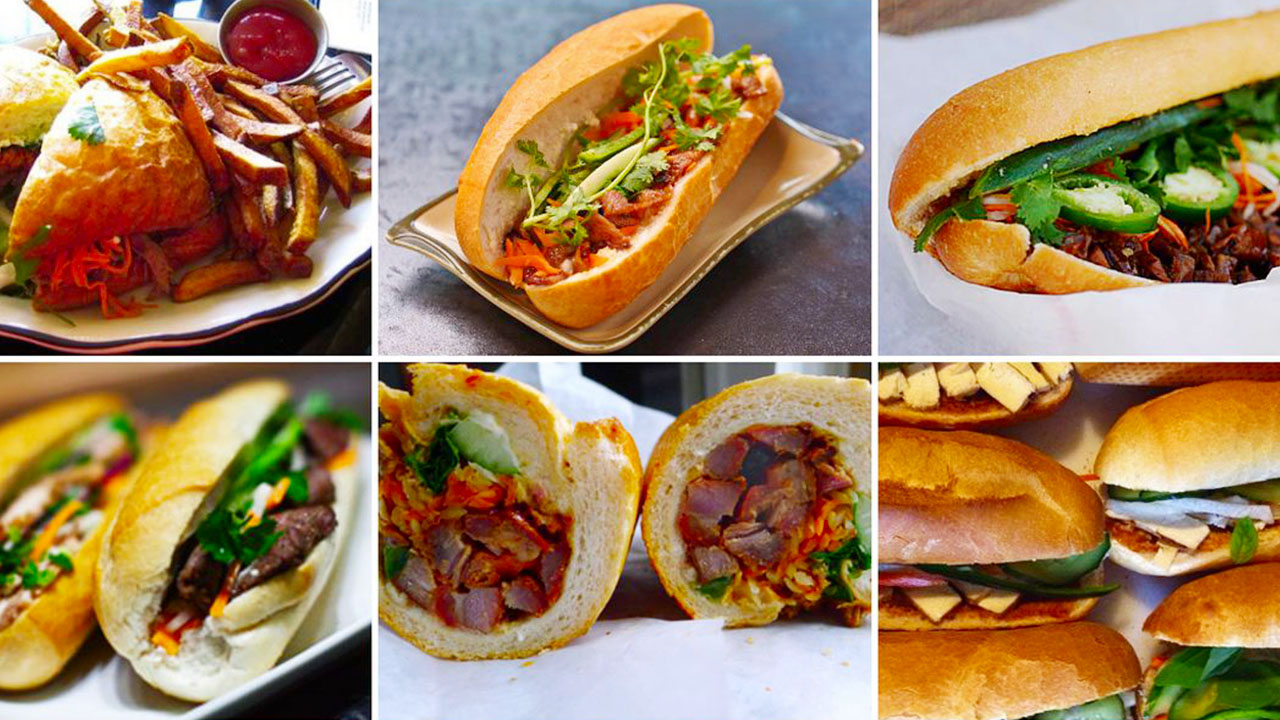
Traditional banh mi
The traditional banh mi, or banh mi thit nguoi, is a straightforward yet deeply satisfying sandwich. This version typically includes a mix of cold cuts such as ham, sausage, and pork pâté, combined with mayonnaise, pickled vegetables, fresh cilantro, and chili peppers. Each component is carefully chosen to create a balanced, flavorful experience.
An authentic traditional banh mi stands out for its simplicity and balance. The crisp baguette contrasts beautifully with the creamy pâté and mayonnaise, while the pickled vegetables add a much-needed tang to counter the fattiness of the meats. Fresh herbs and chilies complete the sandwich with a burst of freshness and heat.
Regional variations
Vietnam is a diverse country, and its culinary landscape reflects this diversity. As the banh mi traveled from Saigon to other parts of the country, each region added its unique twist to this classic sandwich.
- Banh Mi Hanoi: Known for its simplicity, the Hanoi version often includes lighter ingredients such as pâté, pork, chicken, and corn, balanced with butter, mayonnaise, and chili.
- Banh Mi Hai Phong: Also called Banh Mi Que, this version is narrow and contains mainly pâté and chili, offering a spicier, more compact eating experience.
- Banh Mi Hoi An: Hailing from the ancient town of Hoi An, this version is known for its wide variety of fillings, including ham, sausages, pork barbecue, and cheese, each shop often boasting its secret butter and sauce recipes.
- Banh Mi Saigon: The vibrant city of Saigon offers an array of fillings, from simple cold cuts to more luxurious options like grilled meats and diverse condiments, reflecting the fast-paced lifestyle of the city.
These regional variations highlight the creativity and adaptability of Vietnamese cuisine. Each version offers a distinct take on the classic sandwich, ensuring there’s something for everyone.
Vegetarian and vegan options
With the growing demand for plant-based diets, vegetarian and vegan banh mi options have become increasingly popular. Hanoi, in particular, offers a diverse range of vegetarian and vegan banh mi, catering to both locals and tourists.
- Bánh mì an lạc: This “peace banh mi” features vegetarian meatballs, mushroom char siu, and vegetarian sausage, providing a protein-rich alternative.
- Bánh mì thập cẩm chay: A mixed vegetarian banh mi filled with various plant-based proteins like tofu, seitan, mushrooms, and soy protein.
- Bánh mì nấm ngũ vị chay: This five-spice mushroom banh mi offers a flavorful and aromatic filling that pairs beautifully with the traditional baguette.
- Bánh mì căn nướng chay: Grilled faux meat banh mi provides a satisfying texture and taste that closely mimics grilled pork or chicken.
- Bánh mì xíu mại chay: Featuring vegetarian shu mai, this banh mi offers a tender and juicy filling.
- Bánh mì cà ri chay: Curry with bread banh mi is a unique variant that includes rich and aromatic curry flavors.
Vegetarian and vegan banh mi sandwiches maintain the balance and complexity of flavors that make banh mi so beloved, ensuring that everyone, regardless of dietary preference, can enjoy this iconic Vietnamese treat.
Popular banh mi ingredients
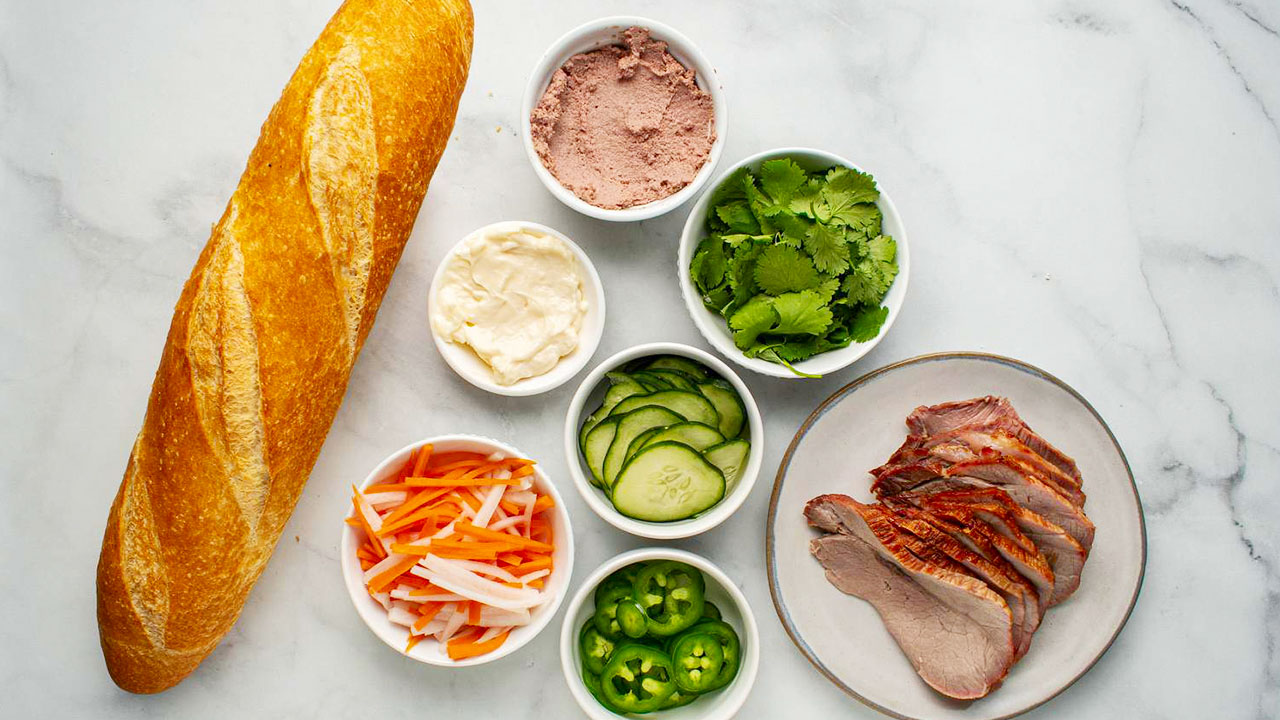
Bread and baguettes
The foundation of any great banh mi is the bread. The traditional Vietnamese baguette, known locally as banh mi, is distinct from its French counterpart. It’s typically shorter, lighter, and has a thinner, flakier crust. This unique texture is achieved through a combination of rice and wheat flour, which gives the bread its signature crunch and airy interior.
In Hanoi, the bread is often slightly toasted to enhance its crispiness. While the traditional baguette remains the most popular choice, some vendors experiment with other types of bread, such as whole-grain or gluten-free options, to cater to diverse tastes and dietary needs. However, the essence of a good banh mi lies in the harmonious contrast between the crunchy exterior and the soft, pillowy interior, regardless of the type of bread used.
Proteins: meat and alternatives
Proteins are the heart of any banh mi, providing substance and flavor. Traditional options include various cold cuts, grilled meats, and even seafood in some regional variations:
- Pork: Often grilled or roasted, pork is a staple in many traditional banh mi sandwiches. Common variants include pork sausage and pork pâté.
- Beef: Beef tendon, dried beef, and meatballs are popular choices, especially in Hanoi.
- Chicken: Grilled chicken offers a lighter yet equally flavorful option.
- Seafood: While less common, some coastal regions offer banh mi with seafood fillings like shrimp or fish.
For those who prefer vegetarian or vegan options, a variety of plant-based proteins are available, such as tofu, seitan, mushrooms, and other meat substitutes. These alternatives are often marinated and cooked in traditional Vietnamese spices to mimic the flavor and texture of their meat counterparts.
Condiments and vegetables
The condiments and vegetables are what give banh mi its distinctive flavor profile. A blend of savory, tangy, and spicy elements, these ingredients bring balance and freshness to the sandwich:
- Pâté: A savory spread made from liver, often pork liver, adds richness and depth.
- Mayonnaise: This creamy condiment is often used to bind the various elements together.
- Pickled vegetables: Carrots, daikon radish, and cucumbers are pickled in a mix of vinegar, sugar, and salt, providing a tangy crunch.
- Fresh herbs: Cilantro, chives, and mint are commonly used to add aromatic freshness.
- Chili sauce and fresh chilies: These add a spicy kick, balancing the richness of the meats and condiments.
- Soy sauce and fish sauce: These umami-rich sauces deepen the overall flavor profile.
Together, these ingredients create a symphony of textures and flavors, making each bite of banh mi a delightful experience.
The best banh mi spots in Hanoi
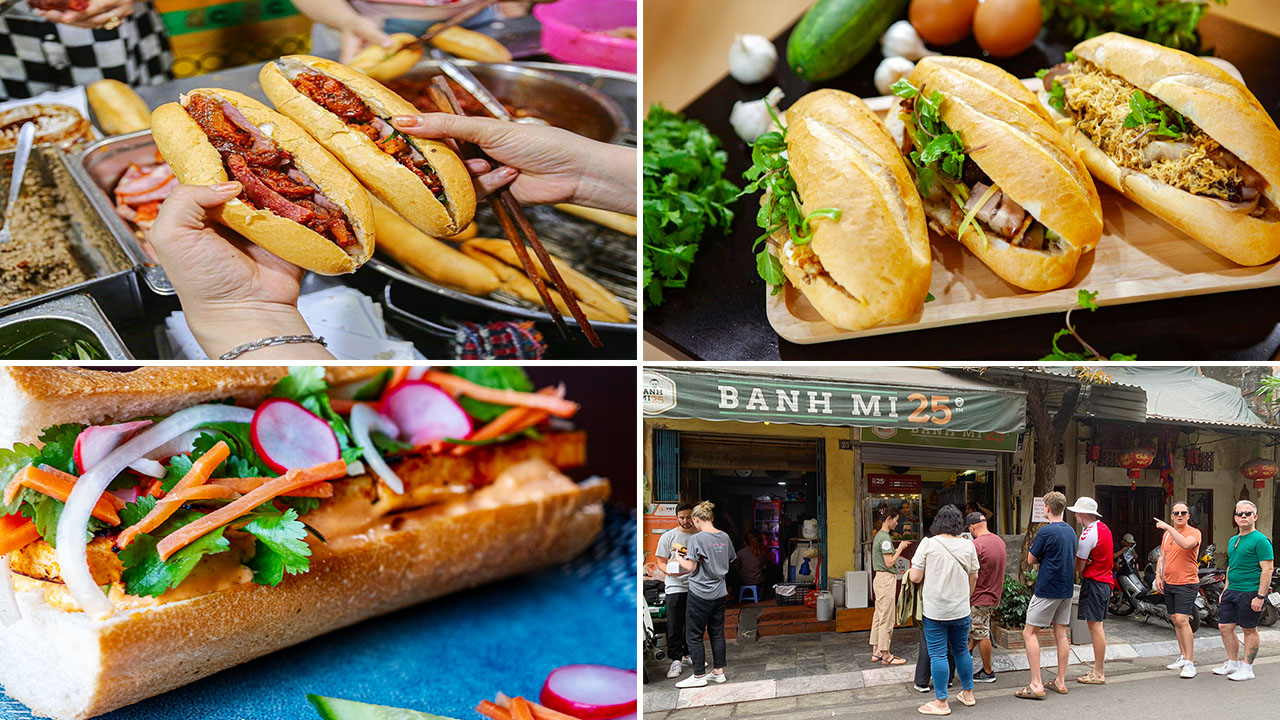
Banh mi 25
- Price: 30,000 – 45,000 VND
- Address: 25 Hang Ca street, Hoan Kiem district, Hanoi
- Opening time: 07:00 AM – 9:00 PM
Located in the heart of Hanoi’s Old Quarter, Banh Mi 25 is a must-visit for any banh mi enthusiast. Known for its exceptional quality and dedication to being plastic-free, this eatery offers a wide range of flavors that cater to both traditionalists and those seeking something new. The vintage-themed decor adds a touch of nostalgia, making it a cozy spot to enjoy a meal.
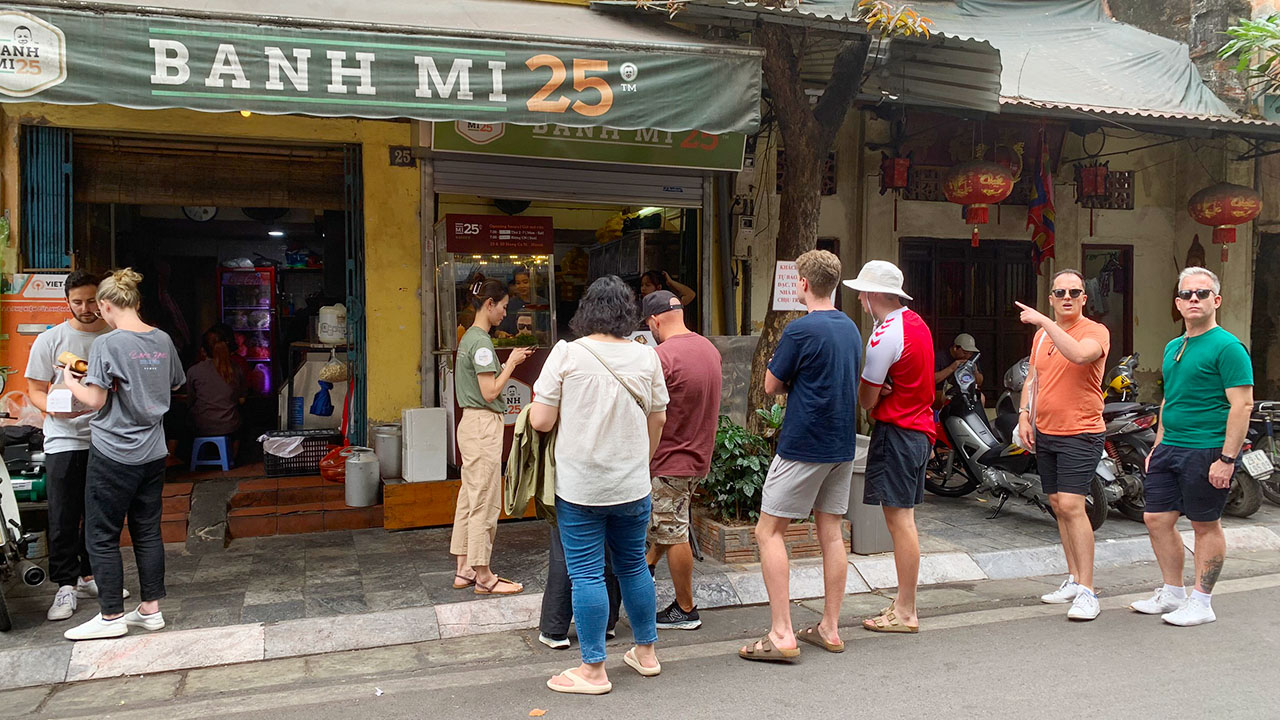
Their menu is diverse, with options for vegetarians and meat lovers alike. A standout feature is their homemade sauces, which elevate their sandwiches to new heights. Prices are reasonable, ranging from 30,000-45,000 VND (~$1.30-$2 USD), making it accessible for locals and tourists alike.
Bami An Bread
- Price : 20,000 – 50,000 VND
- Address: 98 Hang Bac Street, Hoan Kiem District, Hanoi
- Opening time: 6:45 AM – 22:00 PM
Another gem in Hanoi Old Quarter is Bami An Bread, also known as Bami Bread. This establishment starts serving early in the morning, focusing mainly on takeout orders. What sets Bami Bread apart is its unique Hoi An sauce, a secret ingredient that gives their sandwiches a distinct, smooth flavor.
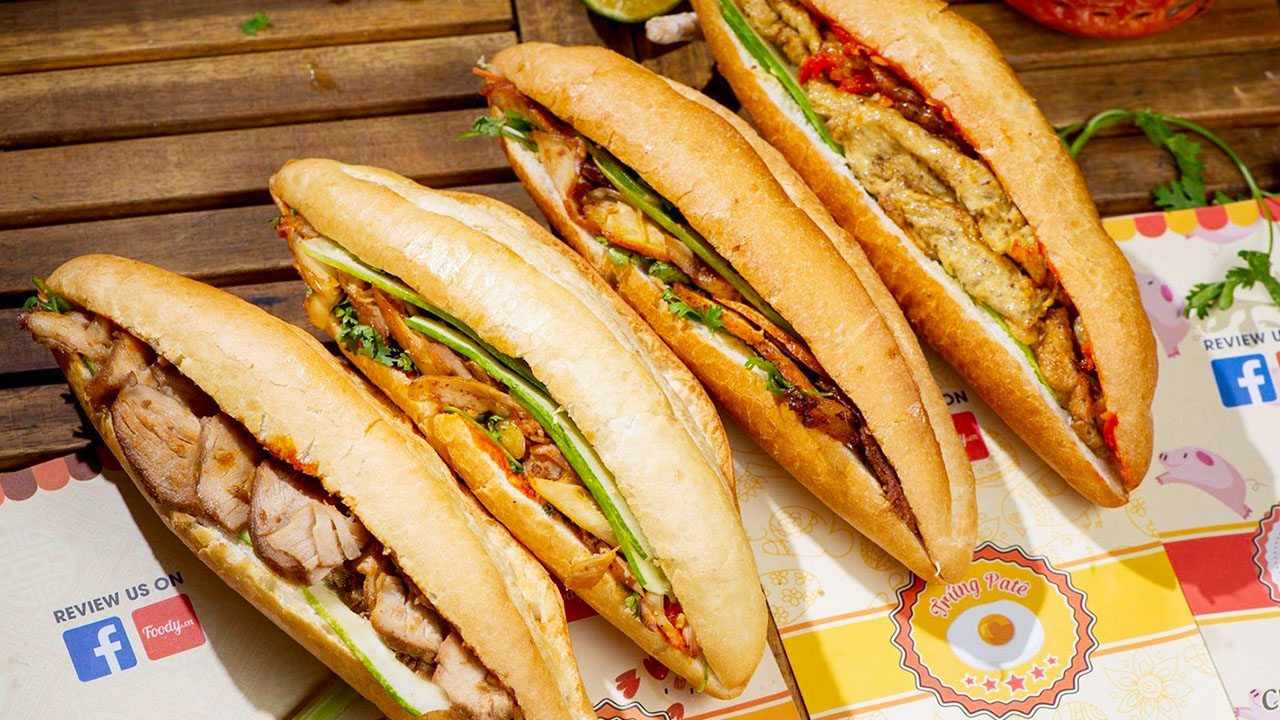
Their sandwiches might seem ordinary at first glance, typically featuring beef, pork, and vegetables. However, the magical touch of the Hoi An sauce takes them to another level. The combination of fresh, high-quality ingredients and this special sauce creates a truly unforgettable culinary experience.
Banh Mi Pho
- Price : 20,000 – 50,000 VND
- Address: 118A Hue street, Hai Ba Trung district, Hanoi
- Opening time: 8 AM – 5 PM
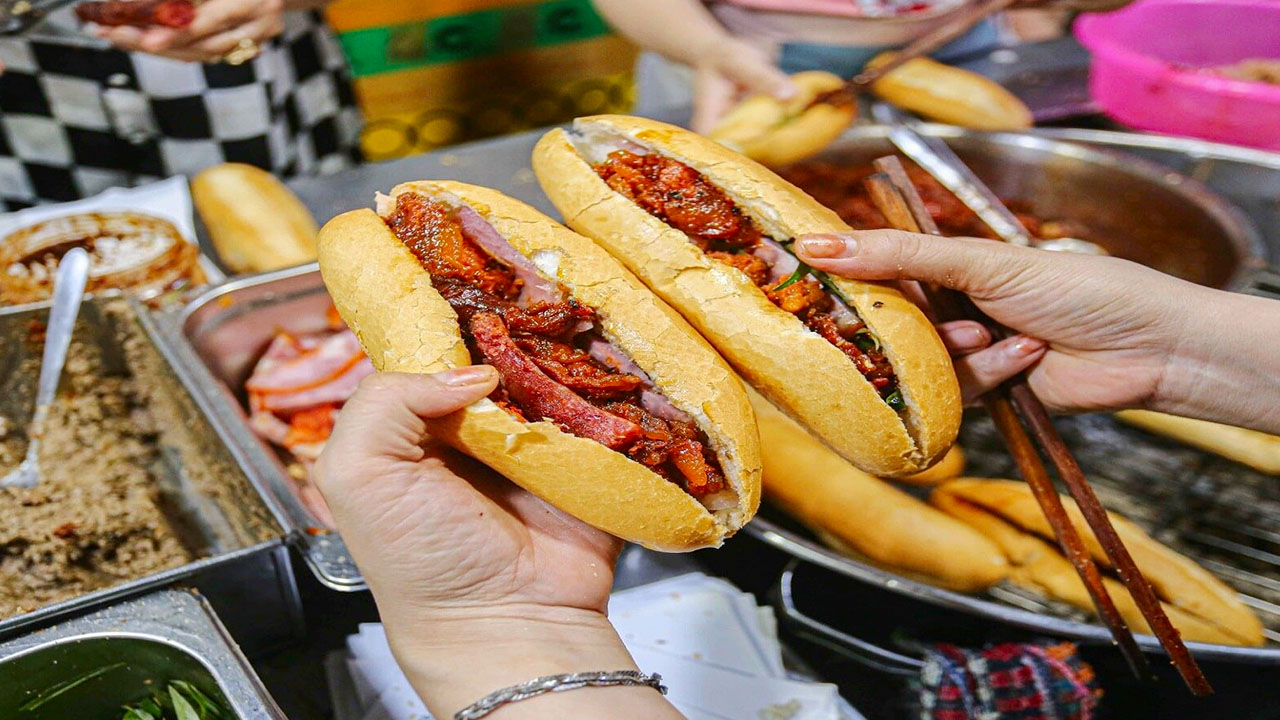
A Hanoi institution, Banh Mi Pho Hue has been serving up delicious banh mi for over 40 years. Known for its homemade chili sauce and a variety of toppings like shredded pork, Vietnamese sausage, cold cuts, and barbecued pork, this spot has garnered a loyal following. The blend of flavors and textures in their sandwiches is unparalleled, making it a top choice for locals and tourists alike.
Banh Mi Mama
- Price : 20,000 – 30,000
- Address: 54 Ly Quoc Su Street, Hoan Kiem District, Hanoi
- Opening time: 7:00 AM – 20:00 PM
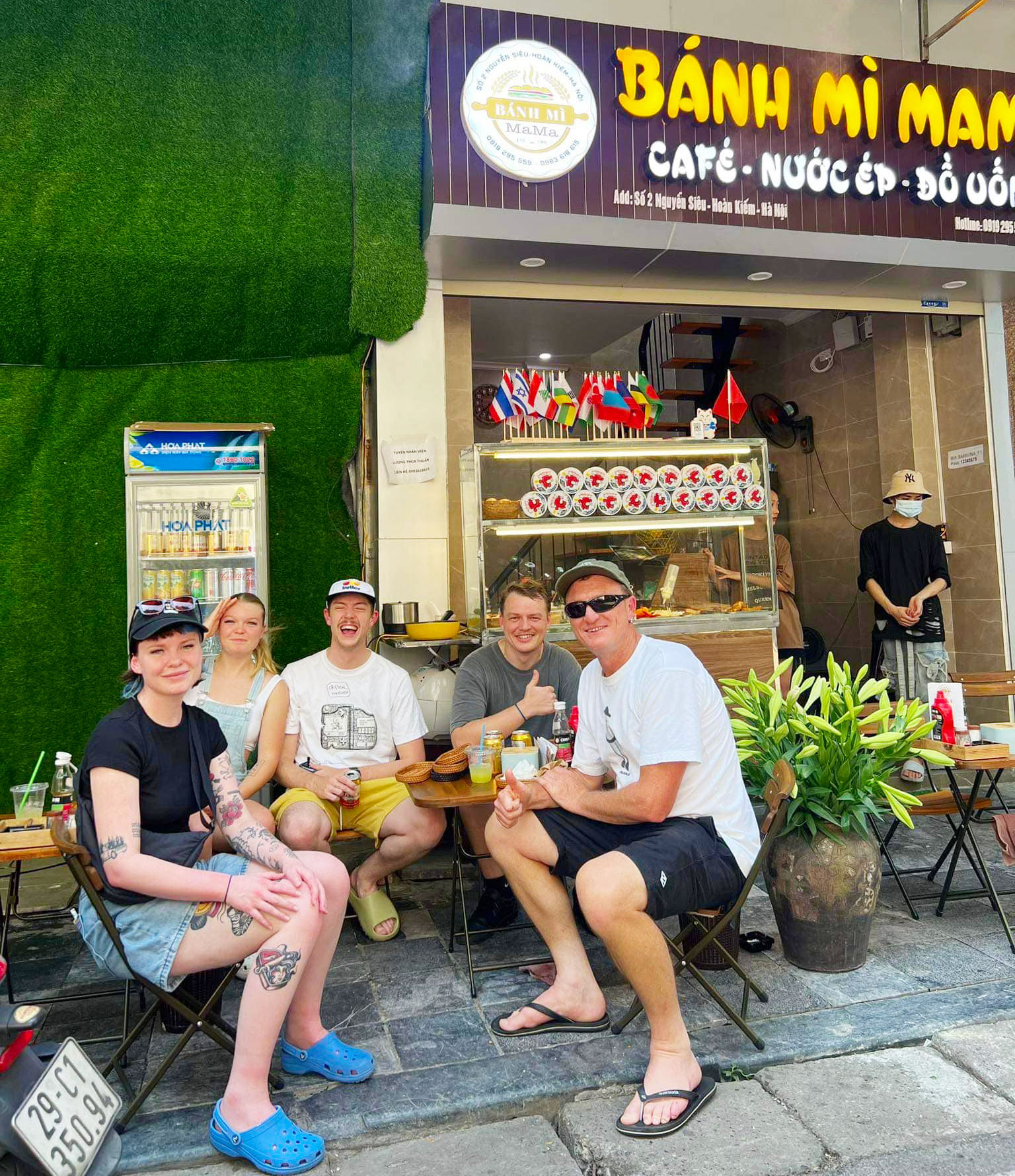
While there isn’t a well-known establishment called Banh Mi Mama in Hanoi, there are several other notable spots worth mentioning. For instance, Banh Mi Ba Dan, Banh Mi Nguyen Sinh, Banh Mi Vui, Banh Mi Ba Nga, and Banh Mi Tram are all celebrated for their unique takes on the classic sandwich. Each of these vendors brings something special to the table, whether it’s a secret sauce, a unique filling, or a particular method of preparation.
Vegan Banh Mi
- Price : 20,000 – 30,000
- Address: 15 Tho Nhuom streeet, Hoan Kiem district, Hanoi
- Opening time: 11:00 AM – 7:30 PM
For those seeking vegan options, Hanoi has plenty to offer. Vegan Banh Mi, located in an alley, is a small family-run restaurant that serves a variety of vegan sandwiches, including their signature “Shumai Banh Mi.” Prices are affordable, ranging from 20,000-30,000 VND (~$0.90-$1.30 USD), making it a great choice for budget-conscious travelers.
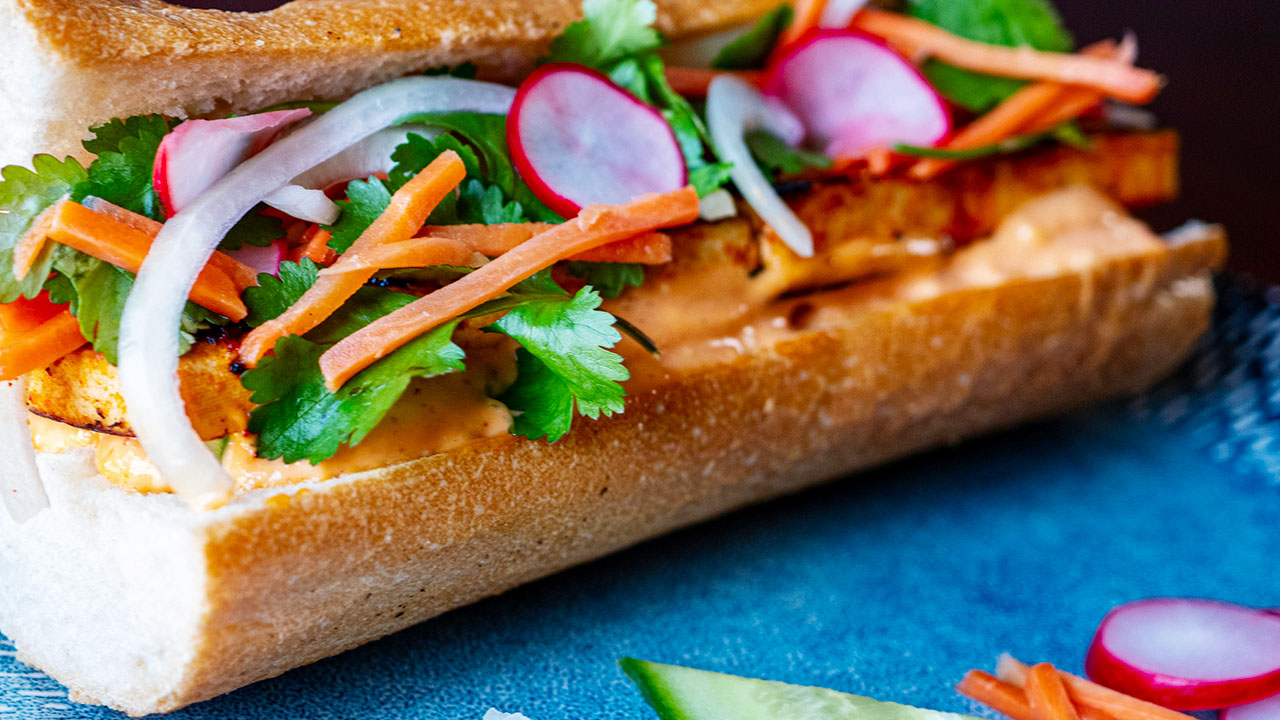
Other notable spots include Banh Mi Vegan at 15 P. Thợ Nhuộm and Bánh Mỳ Thuần Chay Vegan at 324 P. Khâm Thiên. Both offer a range of nutritious and flavorful fillings like pickled veggies, tofu, and special sauces, priced between 30,000-40,000 VND (~$1.30-$1.70 USD).
Bánh Mì Tram
- Price: 20,000 – 40,000 VND
- Address: 30 Dinh Ngang Street, Hoan Kiem District, Hanoi
- Opening time: 07:30 AM – 22:00 AM
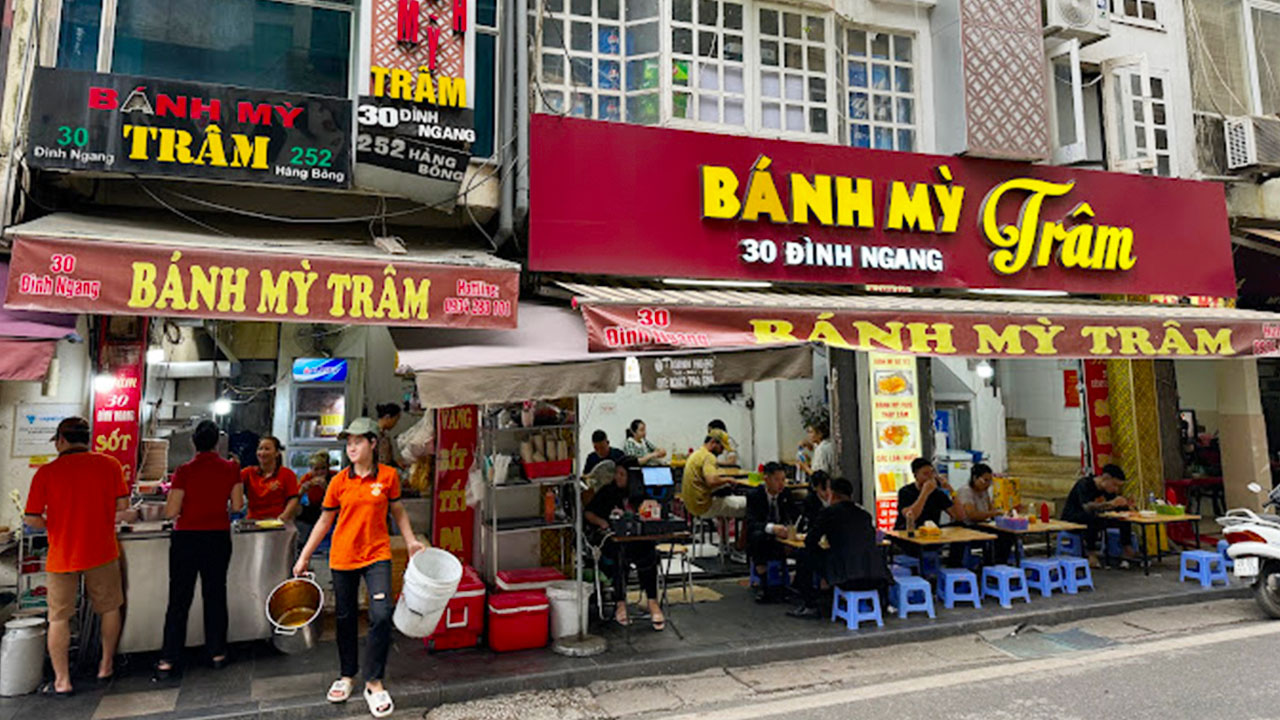
Bánh Mì Tram is another beloved spot in Hanoi, known for its deconstructed banh mi concept. Here, the baguette and fillings are served separately, allowing customers to assemble the sandwich themselves. This innovative approach, combined with their signature sauce, has made Bánh Mì Tram a favorite among both locals and tourists.
Banh Mi Pho Co
- Price: 20,000 – 40,000 VND
- Address: 38 Dinh Liet street, Hoan Kiem district, Hanoi
- Opening time: 07:30 AM – 12:00 AM
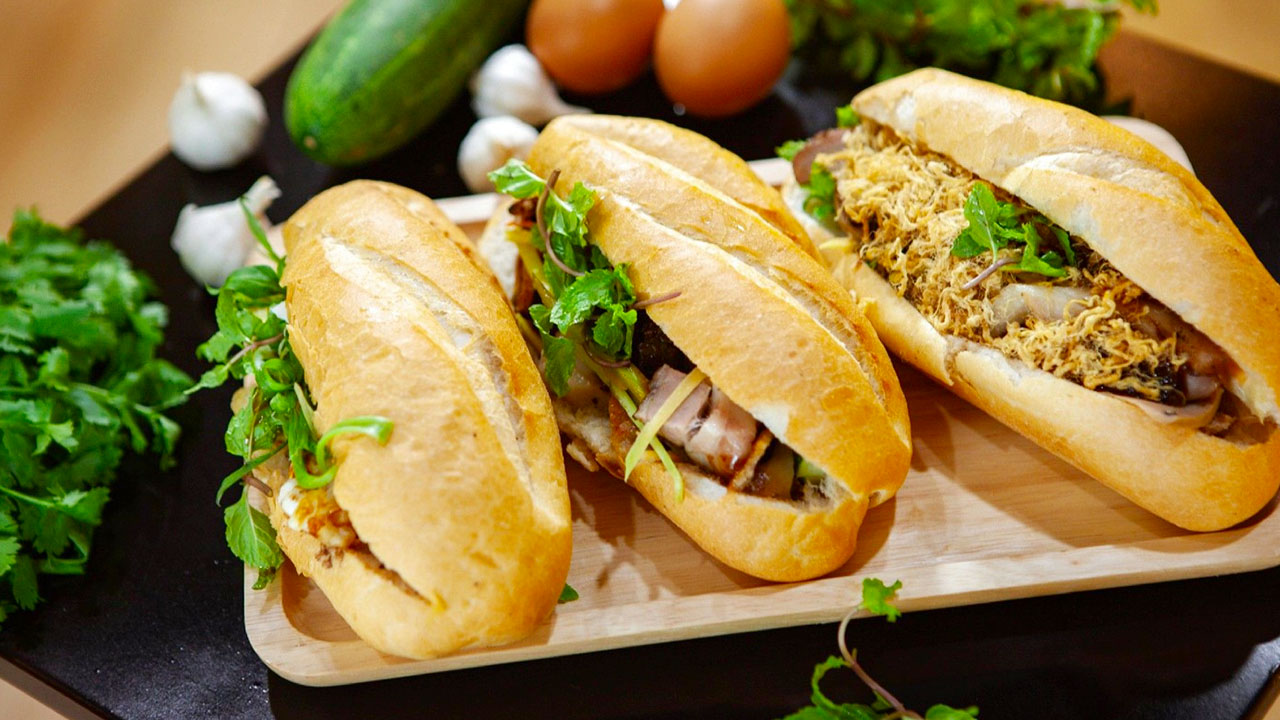
If it is an authentic Banh Mi Hanoi experience you seek, the Banh Mi Pho Co stall in Hanoi’s vibrant Old Quarter is the place to go. They have been serving locals and international tourists for generations, and have become known for their dedication to preserving the traditions of this famous Vietnamese sandwich.
The quality and flavor of their ingredients is a vital part of this dedication. All their ingredients are locally sourced to maintain the distinctive flavors, making it a banh mi experience that is truly authentic. The meats are carefully marinated to perfection and are complemented with pickled vegetables sauces. The combination of these elements creates a satisfying flavor journey that perfectly complements the expertly-baked baguette.
Banh Mi Lan Ong (Bánh mì Lãn Ông)
- Price: 15,000 – 35,000 VND
- Address: 20 Cha Ca street, Hoan Kiem district, Hanoi
- Opening time: 7 AM – 10 PM
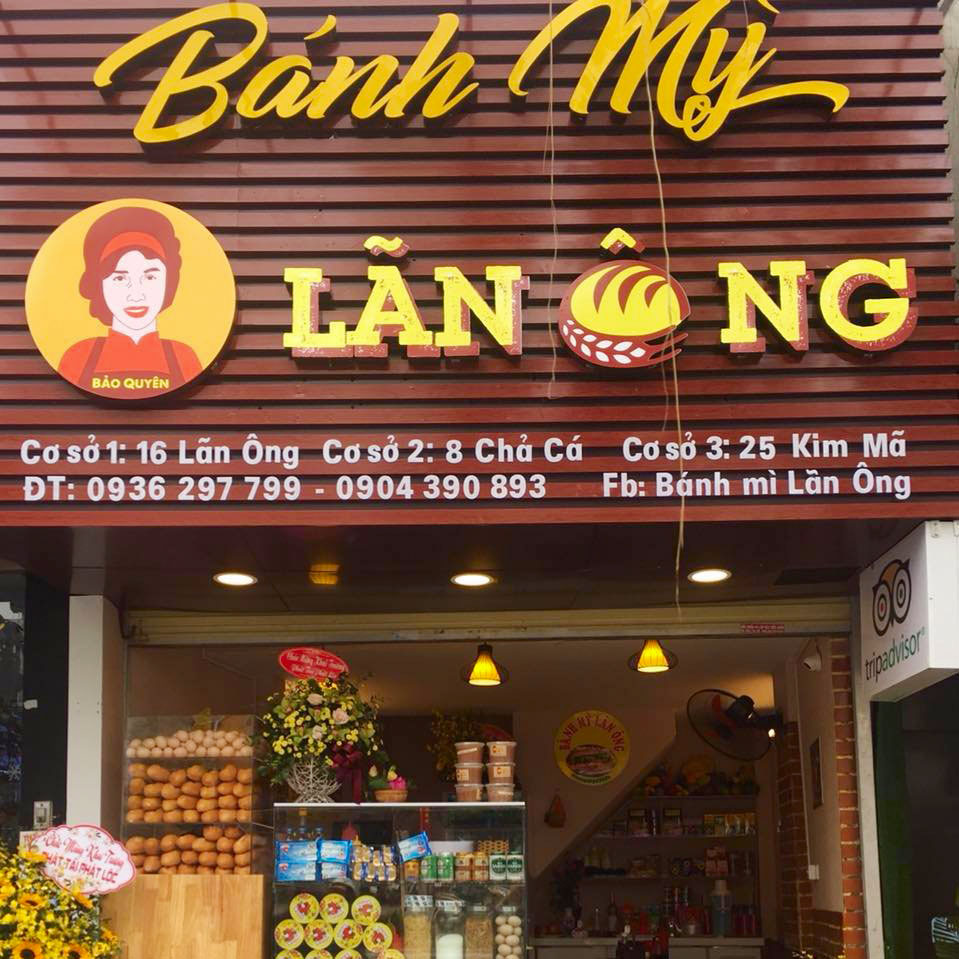
As the saying goes, “Save the best for last.” Banh Mi Lan Ong is a hidden gem nestled in the heart of Hanoi’s Old Quarter. This small, unassuming stall might not catch your attention at first glance, but the banh mi it offers is truly a revelation.
What makes Banh Mi Lan Ong special is its secret family recipe that has been passed down for generations. The stall’s signature banh mi features succulent grilled pork, homemade pate, and a flavorful sauce that elevates the entire experience. The combination of flavors, coupled with the warm hospitality of the stall owners, creates an unforgettable culinary adventure.
How to make banh mi at home
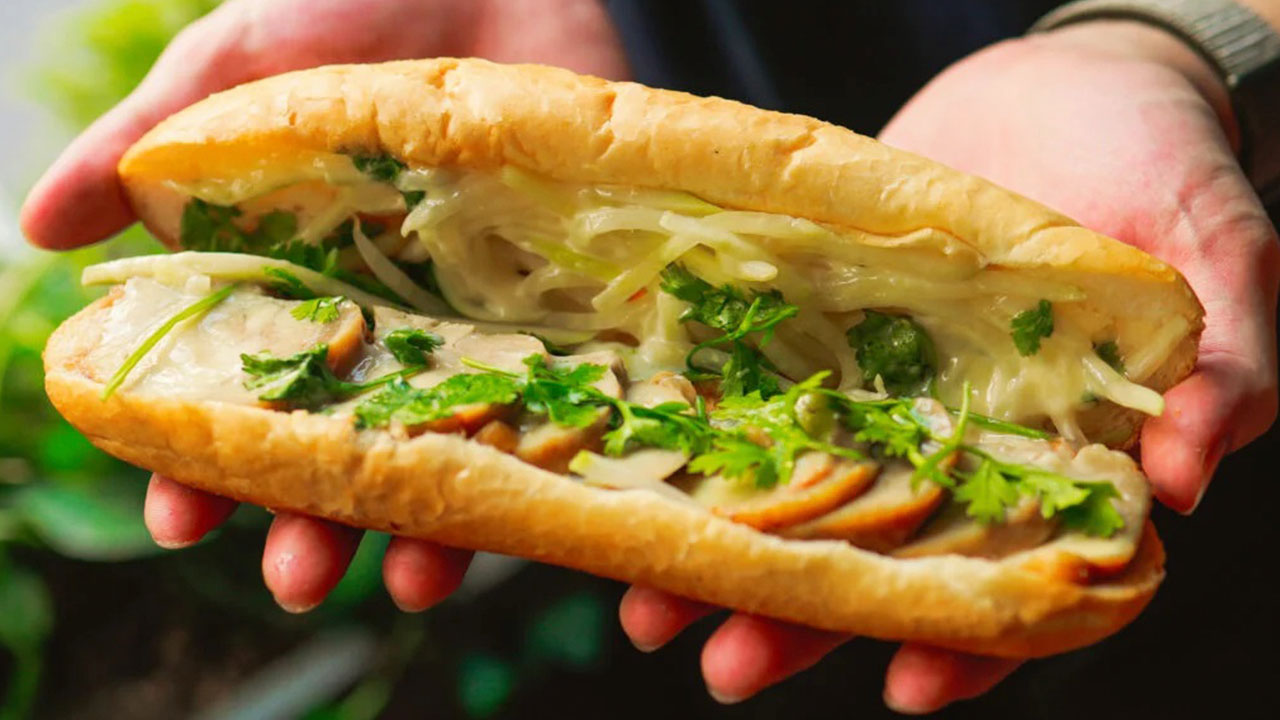
Essential ingredients
Creating the perfect banh mi at home requires attention to detail and high-quality ingredients. Here’s what you’ll need:
- Baguette: Look for a crusty, airy French-style baguette.
- Pâté: Opt for either chicken or pork pâté for an authentic taste.
- Meats: Vietnamese sausage, cold cuts, or grilled meats like lemongrass chicken or roasted pork belly.
- Pickled vegetables: Carrots and daikon radish are essential. Quick-pickle them in vinegar, sugar, and salt.
- Fresh herbs: Cilantro, mint, and Thai basil add aromatic freshness.
- Condiments: Mayonnaise, chili sauce, soy sauce, and Maggi seasoning.
- Additional toppings: Cucumber slices, green onions, and fresh chilies.
Step-by-step recipe
- Prepare the Pickled Vegetables: In a small pot, combine water, vinegar, salt, and sugar. Add peeled and julienned carrots and daikon radish. Bring to a simmer, then remove from heat and let cool completely.
- Make the Marinade: In a small bowl, whisk together olive oil, tamari, lime juice and zest, garlic, ginger, and pepper. Place your choice of protein, such as tofu or chicken, in a shallow pan and pour the marinade over, flipping to fully coat. Let marinate for at least 15 minutes.
- Slice the Bread: Cut baguettes in half lengthwise, but leave the back part uncut so the loaf stays intact.
- Assemble the Banh Mi: Spread a layer of mayonnaise and pâté on the bottom half of the bread. Layer in the protein, pickled vegetables, cucumber slices, cilantro, green onions, and chili slices. Drizzle with Maggi seasoning or soy sauce.
- Compress the Sandwich: Gently press the sandwich together to secure the layers.
By following these steps, you can bring the authentic taste of Hanoi’s street food into your own kitchen.
Exploring banh mi culture
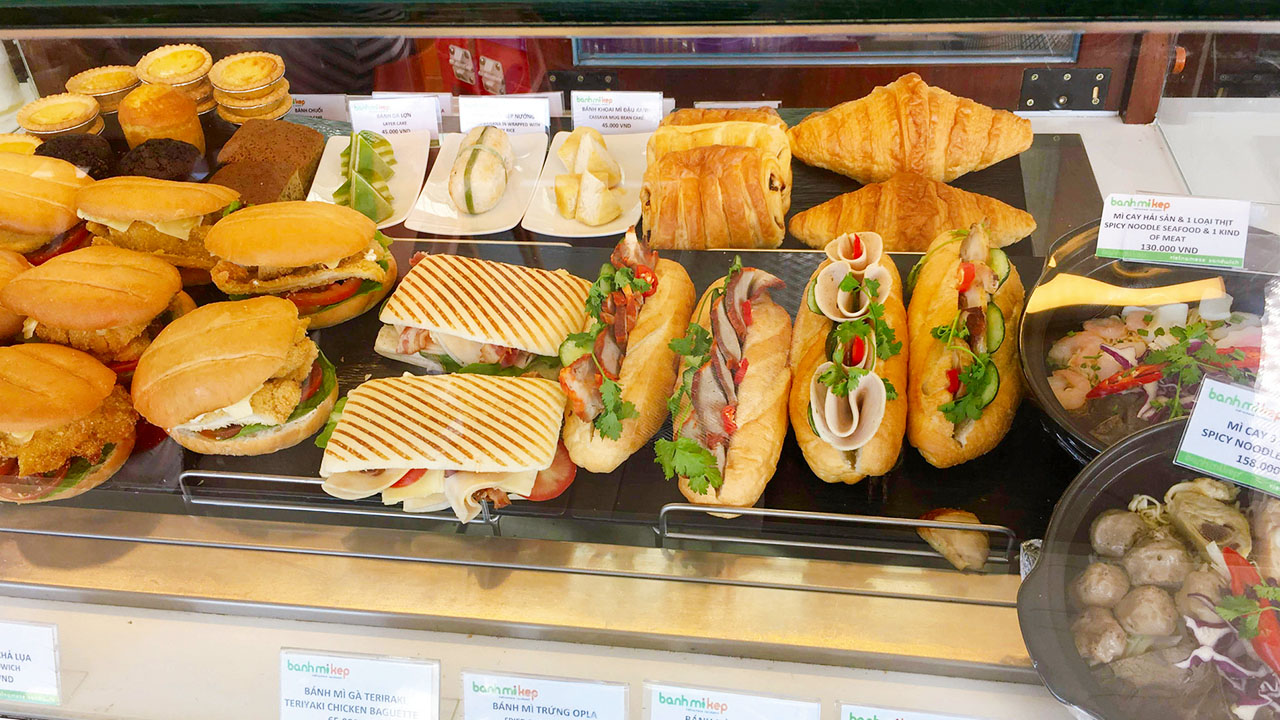
Banh mi as street food
In Vietnam, banh mi is more than just a sandwich; it’s a staple of street food culture. It’s quick, affordable, and incredibly flavorful, making it the perfect meal for people on the go. Street vendors can be found on nearly every corner in Hanoi, each with their unique take on this iconic sandwich.
The beauty of banh mi as street food lies in its accessibility. For just 20,000-50,000 VND (~$0.90-$2.20 USD), you can enjoy a freshly made sandwich that’s packed with high-quality ingredients. Street vendors often make their bread, pâté, and pickled vegetables from scratch, ensuring that every bite is bursting with flavor.
Compared to Western fast food, which often prioritizes convenience over quality, banh mi offers the best of both worlds. It’s fast and convenient, but also made with care and attention to detail. This combination of speed and quality is what makes banh mi a beloved part of Vietnamese street food culture.
The role of banh mi in Vietnamese cuisine
The banh mi sandwich plays a significant role in Vietnamese cuisine and culture, serving as a bridge between the past and the present, the east and the west. Its origins can be traced back to the French colonial period, but its evolution into an iconic Vietnamese dish reflects the country’s ability to adapt and innovate.
In Hanoi, banh mi has become a beloved street food and a cultural icon. Vendors take pride in their craft, often passing down their recipes and techniques through generations. The banh mi of Hanoi is characterized by its balance of flavors, high-quality ingredients, and meticulous preparation.
In a broader sense, the banh mi embodies the spirit of Vietnamese cuisine: a harmonious blend of flavors and textures that delight the senses. It’s a testament to Vietnam’s culinary prowess and its ability to create something unique and unforgettable from simple ingredients.
Conclusion: the future of banh mi in Hanoi
As Hanoi continues to evolve, so too does its culinary landscape. The banh mi, a symbol of the city’s rich history and vibrant street food culture, will undoubtedly remain a beloved staple. With increasing demand for vegetarian and vegan options, vendors are continuously innovating to cater to diverse tastes and dietary needs.
The future of banh mi in Hanoi looks promising, with new vendors and eateries emerging, each bringing their unique take on this iconic sandwich. As more people discover the joy of banh mi, both locally and globally, this humble sandwich will continue to be a cherished part of Vietnamese culture.
Whether you’re exploring the bustling streets of Hanoi or recreating the magic of banh mi in your own kitchen, one thing is certain: the allure of this delightful sandwich is here to stay.


